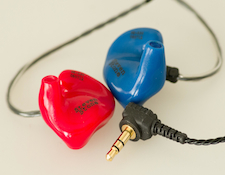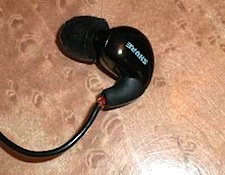It’s the time of year for saving money!

When you modify something the goal is to end up with something different, and hopefully better, than the stock unit. But in our current worldly dimension there’s no guarantee that a modification will yield a better result. Here’s my story…
I had two pairs of Shure E500 PTH in-ear earphones. One pair had been subjected to several years of workouts and the cable had begun to crack in a few spots close to the enclosures and the cable’s conductors had turned a sickly green color due to moisture. My second pair are virtually mint, acquired just before Shure officially discontinued the E500 in favor of the SE530.
Since my original pair were near the end of their useful life I considered my options. I could send them back to Shure, who would most likely offer to replace them with a current model for a slightly reduced price (usually between $250 and $350) or I could have them re-shelled and re-cabled by a third-party. Since I already had one pair of custom in-ear monitors, the fine Ultimate Ears In Ear Reference Monitors, I thought it would be interesting to see how re-shelling and re-cabling would affect my E500’s. Also, since I have a stock pair in original condition, I figured it would be educational to see how the re-shelled version differed sonically from the stock earphones.
For those audiophiles not familiar with the term, re-shelling; it consists of removing the guts of an earphone or earbud and placing it into a custom form made from impressions taken of your ear canals. The final result is a custom in-ear that should fit your ear canal perfectly.
One firm that has developed an excellent reputation for re-shelling earphones is Fisher Hearing, located in Florida. Their website has complete instructions for getting ear impressions from a local source. I used an audiologist in Boulder, CO, who charged me $50 for a set of impressions. Then I then mailed my impressions to Fisher along with my old E500s. Fisher charges $150 for remolding and an additional $30 for re-cabling. For $180 plus shipping one-way I would get back a pair of custom in-ears based on the Shure E500 assembly. About three weeks later I got my “new” earphones in the mail.
Although you can get very fancy with colors and designs on your remolds, I opted for a simple scheme – the right earbud is red while the left one is blue and my name is one both in small upper case. Unless I become very colorblind, this makes it easy to tell which earbud goes on which side of my head. The fit, which is critical for a custom in-ear to perform optimally, was perfect on the left ear, and almost correct on the right. After about ½ hour of listening the right earphone often slipped out of place slightly, requiring a push to reposition. On my second trip to the audiologist who did the initial fitting I had the length of the right earphone shortened about .5 mm which eliminated the fit issue.
And how do the re-shelled E500’s sound? Different. The harmonic balance of the re-shelled earphones displayed a quite noticeable bass roll-off starting around 500 Hz and becoming more severe as the frequency went lower. It was quite obvious that the interior dimensions of the new shells reduced the E500’s bass output substantially. And then it dawned on me – Shure uses its casing to augment bass extension. And why not? It makes perfect sense to do what speaker makers have done since earliest times – use the enclosure size to complement the bass response. Unfortunately the Fisher Hearing shell just doesn’t have the same internal dimensions so naturally it produces a different bass response.

Not all in-ear monitors use their internal dimensions for bass augmentation, so I wouldn’t say, unequivocally, that when you get a pair of earphones re-shelled the bass response will change. But on the Shure E500, the re-shell did cause a quite noticeable reduction is bass.
So do I consider the final results of my experiment a success? Well, no, not completely. I now have a very nice fitting pair of custom in-ears that have what most people would consider too little bass. Fortunately some players have built-in EQ settings. With the most excellent Astell and Kern AK100 I can adjust the bass response to the point where my modded E500’s harmonic balance is very close to what I get from my Etymotic ER-4Ps without EQ.
But, if I had the opportunity to do it all over again, I’d probably opt for letting Shure “replace” my E500s rather than going the re-shell route. But don’t let me dissuade you from re-shelling. With another manufacturer’s offerings whose final harmonic balance is not so dependent on internal dimensions, re-shelling is a great way to extend the life, and your enjoyment, of a well-used set of earphones.





